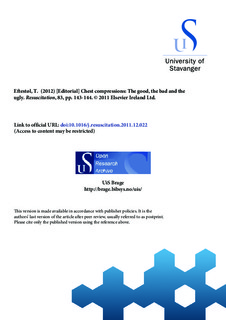| dc.contributor.author | Eftestøl, Trygve | |
| dc.date.accessioned | 2014-05-26T07:54:22Z | |
| dc.date.available | 2014-05-26T07:54:22Z | |
| dc.date.issued | 2012 | |
| dc.identifier.citation | Eftestøl, T. (2012) [Editorial] Chest compressions: The good, the bad and the ugly. Resuscitation, 83, pp. 143-144. | nb_NO |
| dc.identifier.issn | 1873-1570 | |
| dc.identifier.uri | http://hdl.handle.net/11250/195442 | |
| dc.description | © 2011 Elsevier Ireland Ltd. All rights reserved. The author accepted manuscrip is posted here with permission from Elsevier. For article, see doi:10.1016/j.resuscitation.2011.12.022, for journal, see www.elsevier.com/locate/resuscitation. | nb_NO |
| dc.description.abstract | Where exactly is the chest compression, where does it begin, when does it end, how deep does it go and at what rate are they performed? In short – how good or bad is the chest compression? These are some of the questions researchers ask themselves repeatedly. As well as these data, we need to know the proportion of resuscitation time spent giving quality compressions, the ratio of interruptions and several other parameters and we need to evaluate the effect on survival. Considering the increasing capacity for data storage and growing repositories of resuscitation data one might also ask what proportion of valuable research time is spent in analysing compressions. | nb_NO |
| dc.language.iso | eng | nb_NO |
| dc.publisher | Elsevier Ltd. | nb_NO |
| dc.subject | VDP::Medisinske Fag: 700 | nb_NO |
| dc.subject | VDP::Matematikk og Naturvitenskap: 400::Informasjons- og kommunikasjonsvitenskap: 420 | nb_NO |
| dc.subject | resucitation | nb_NO |
| dc.subject | data analysis | nb_NO |
| dc.title | Chest compressions: The good, the bad and the ugly | nb_NO |
| dc.type | Journal article | nb_NO |
| dc.source.pagenumber | 143-144 | nb_NO |
| dc.source.volume | 83 | nb_NO |
| dc.source.journal | Resucitation | nb_NO |
| dc.identifier.doi | 10.1016/j.resuscitation.2011.12.022 | |
